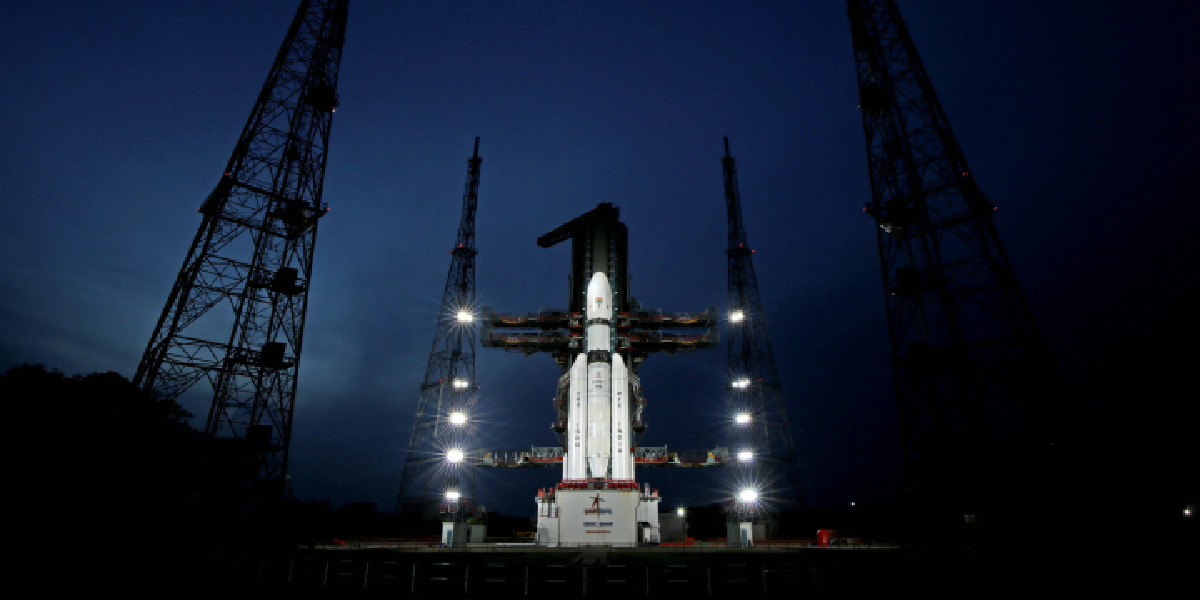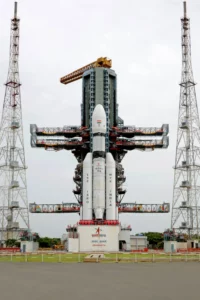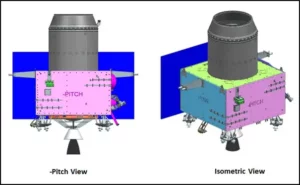Chandrayaan-3 is India's lunar exploration mission aimed at achieving a safe soft landing on the Moon's surface and conducting surface exploration with a rover.

Chandrayaan-3 main goal is to demonstrate the ability to safely land on the moon's surface and move around it. (ISRO)
In a world filled with video games, social media, and ever-evolving entertainment options, one might wonder why a 15-year-old kid would get excited about a moon mission.
Yet, the fascination and enthusiasm for space exploration persist among the younger generation, as seen in the case of Avik Prakash, a ninth-grade student from Hyderabad.
“The vastness and beauty of the cosmos have always mesmerised me. Exploring the unknown and expanding our knowledge about the universe is something I find truly exhilarating,” Avik told South First.
His excitement for the upcoming Chandrayaan-3 mission by the Indian Space Research Organisation (ISRO) has infected those around him.
Avik’s fascination with the mysteries of the universe began at a young age, sparking an insatiable curiosity that continues to drive him.
“I’m eagerly awaiting the moment when Chandrayaan-3 lifts off,” he exclaimed. “To witness the culmination of years of scientific research and hard work will be an unforgettable experience.”
He added that he became enamoured with outer space in Class 6, after reading about the discovery of water on the surface of the moon by Chandrayaan-1.
Recalling the previous Chandrayaan-2 mission, which faced challenges during its lunar landing attempt, Avik expressed a mix of disappointment and admiration.
“While the setbacks encountered during Chandrayaan-2 were disheartening, I believe they served as invaluable learning experiences for ISRO. Their determination and resilience have only fuelled my excitement for Chandrayaan-3,” he explained with noticeable enthusiasm.
For a billion people like Avik, four years after the Chandrayaan-2 lander lost control and led to heartbreak, ISRO’s Chandrayaan-3 is all set to soar towards the moon on Friday, 14 July, in an attempt to put the country in an elite club of nations that accomplished lunar missions with a soft landing.

The Chandrayaan programme was conceived by the Government of India and formally announced by former Prime Minister, the late Atal Bihari Vajpayee on August 15, 2003. (ISRO)
Chandrayaan-3 is the next moon mission for ISRO after Chandrayaan-2. Its main goal is to demonstrate the ability to safely land on the moon’s surface and move around it.
This is expected to be the fourth operational mission of the Launch Vehicle Mark-III or LVM3, a multi-use launcher.
ISRO is pushing boundaries by attempting a soft landing on the moon using a special lunar module (a moon-landing spacecraft for experiments, and exploration on topmost surface of the moon) and showcasing the ability to roam on the moon’s terrain.
It will be launched into space from the Satish Dhawan Space Centre Sriharikota Range (SDSC SHAR) spaceport in Sriharikota in Andhra Pradesh, using the LVM3-M4 rocket.
The objectives of the Chandrayaan-3 mission are to demonstrate safe and soft landing on the lunar surface, showcase the rover’s ability to move and explore on the moon, and conduct scientific experiments directly on site.
Chandrayaan-1 was India’s first lunar mission. It was launched on 22 October, 2008, and its main objective was to orbit the moon and gather scientific data.
The spacecraft carried a variety of instruments and payloads to study the moon’s surface, mineral composition, and atmosphere, besides looking for the presence of water and/or ice.
Chandrayaan-1 successfully entered the moon’s orbit and operated for nearly a year, sending back important data and images.
One of its notable achievements was the discovery of water molecules on the moon’s surface, particularly in the polar regions. This finding provided significant insights into the moon’s history and potential future missions.
Although the mission came to an end in August 2009 when communication with the spacecraft was lost, Chandrayaan-1 marked a significant milestone for India’s space programme and demonstrated the country’s capability to explore and conduct scientific research on the moon.
It paved the way for future lunar missions, including Chandrayaan-2 and the upcoming Chandrayaan-3.
Chandrayaan-2 encountered a partial failure during its mission.
The specific reason for the failure was the deviation of the lander module’s trajectory during its descent to the lunar surface.
ISRO Chairman S Somanath on Monday, 10 July, shared minute details about what went wrong with the Vikram lander of Chandrayaan-2 as it went hurtling down towards the identified 500 m x 500 m landing spot on the lunar surface, with the engines designed to reduce its velocity developing higher thrust than expected.
“The primary issues were: One, we had five engines which were used to give the reduction of the velocity, which is called the retardation. These engines developed higher thrust than what was expected,” he told reporters on the sidelines of the India Space Congress organised by SIA India.
Somanath said that when such a higher thrust was being experienced, the errors on account of this differential accumulated over some period.
“All the errors accumulated, which was on the higher side of what we had expected. The craft had to make very fast turns. When it started to turn very fast, its ability to turn was limited by the software, because we never expected such high rates to come. This was the second issue,” the ISRO chief said.
He said the third reason for failure was the small 500 m x 500 m site identified for landing the spacecraft.
“The craft was trying to reach there by increasing velocity. It was almost close to the ground and kept on increasing velocity,” Somanath said.
He said instead of the success-based design in Chandrayaan-2, the space agency opted for a failure-based design in Chandrayaan-3.
“We expanded the area of landing from 500m x 500m to 4 km x 2.5 km. It can land anywhere, so it doesn’t limit you to target a specific point. It will target a specific point only in nominal conditions. So, if the performance is poor, it can land anywhere within that area,” Somanath said.
He said the Chandrayaan-3 also has more fuel, and hence more capability to travel or handle dispersion or move to an alternate landing site.
“We looked at very many failures, like sensor failure, engine failure, algorithm failure, and calculation failure. So, whatever the failure, we want it to land at the required speed and rate. So, there are different failure scenarios calculated and programmed inside,” Somanath said.
The ISRO chief said the Vikram lander now has additional solar panels on other surfaces to ensure that it generates power no matter how it lands.
“We asked if it lands with higher velocity, what will happen? Can it not land? Then we increased the vertical velocity component from 2 m/s to 3 m/s and tested it totally,” he said.
The spacecraft was also tested for its ability to withstand vibrations by flying it over different terrains using a helicopter, while cranes were used to test the landing processes, he said.
“We did new test beds for simulation, which was not there last time. This was to look at failure scenarios,” Somanath said.
However, this time scientists have left no stone unturned in an effort to ensure smiles in August, when the landing is planned.
Scientists at the Satish Dhawan Space Centre, after investing many hours of hard work, now aim at mastering the technology of soft-landing on the surface of the moon. Success would make India only the fourth country to achieve the feat — after the United States, China and the former Soviet Union.
The mission is expected to help support future interplanetary missions.
ISRO officials noted that the mission life of the lander is one lunar day, which is equal to 14 Earth days.
The reason to fix the launch window during the month of July — similar to the Chandrayaan-2 mission — is that the Earth and moon would be closer to each other during this part of the year.
“The date (for soft-landing) is decided based on when there is sunrise on the moon. While landing, sunlight must be there. There is sunlight on the moon for 14-15 days and for the next 14-15 days there is no sunlight,” they noted.
Madhavan Nair noted that the national space agency had made a number of simulations and strengthened the systems to resolve the problem faced during Chandrayaan-2 lander’s soft-landing, which was unsuccessful, nearly four years ago.
“This moment I can only say that this mission should succeed in all respects so that we will cross a major milestone in space exploration”, said Nair, under whose six-year tenure as ISRO Chairman and Secretary in the Department of Space from 2003, as many as 25 successful missions were accomplished.
He also had a word of caution ahead of the launch of the Chandrayaan-3 mission on Friday.
“Normally nothing should go wrong. In this game, we can’t say. It’s a big event with so many sub-systems and components working in unison. Even if a minor glitch happens anywhere we can get into a problem, we really have to be cautious,” he said.
The LVM3 rocket, also known as the GSLV Mk III (Geosynchronous Satellite Launch Vehicle Mark III), is a launch vehicle developed by the ISRO. It is designed to launch heavy payloads into space, including satellites and spacecraft.
The LVM3 is the most powerful rocket developed by ISRO and is capable of carrying payloads weighing up to 4 tons to geosynchronous transfer orbit (GTO). It is commonly called the “fat boy”.
With the 43.5-metre-tall rocket, scheduled for liftoff from the second launchpad at 2.35 pm on 14 July, the countdown for the launch began on Thursday.
The LVM3 rocket has completed six consecutive successful missions.
Friday’s mission is the fourth operational flight of LVM3 which aims to launch the Chandrayaan-3 spacecraft into a Geo Transfer Orbit.
The LVM3 vehicle has proved its versatility to undertake most complex missions, including injecting multiple satellites into their specified orbits and interplanetary missions.
It is also the largest and heaviest launch vehicle ferrying Indian and International customer satellites, ISRO said.
The LVM3 rocket is a composite of three modules — propulsion, lander and rover (which is housed inside the lander).
The propulsion module of the LVM3 generates the necessary thrust for a lunar mission.
The lander module is specifically designed to safely touch down on a celestial body like the moon.

Propulsion module of Chandrayaan-. (ISRO)
The rover module, on the other hand, is a mobile robotic vehicle that explores and moves around on the surface of the moon.
The propulsion module is equipped with a payload called SHAPE, which will study Earth by analysing its spectral(looking at the different colours of light to learn about the composition and properties of objects) and polarimetric measurements (focus on the specific way that light waves vibrate to understand the shape and surface properties of things) from the moon’s orbit.
Apart from the SHAPE payload, the propulsion module’s main function is to carry the lander module from the launch vehicle injection orbit to till lander separation.
The lander and rover will be carried by a propulsion module until they reach a lunar orbit of 100 km.
The lander module carries payloads for conducting experiments such as measuring thermal conductivity, temperature assessment, monitoring seismic activity, and studying plasma density variations.
On the soft-landing of the lander module which the ISRO planned to attempt on 23 or 24 August, veteran space scientist and ex-ISRO chief G Madhavan Nair said: “It’s a very difficult and very very complex manoeuvre, and we are doing it for the first time in an unknown territory and to that extent there is a lot of anxiety. We have to wait and see.”
Chandryaan-2 lost contact during the soft landing of the lander.
After the lander module safely lands on the moon’s surface, important instruments called payloads begin their work.
These payloads have different tasks. One of them, RAMBHA-LP, will measure the density of charged particles like ions and electrons near the moon’s surface and observe changes.
Another payload called ChaSTE will measure the temperature and other properties of the lunar surface near the polar region.
Lastly, there is ILSA, which will help detect and study any seismic activity or vibrations near the landing site. It will also help in understanding the structure of the moon’s crust and mantle.
These instruments are crucial for gathering valuable information about the moon’s environment and geological features.
There are also special devices called altimeters that can measure the height above the ground using lasers and radio waves. Then there are velocimeters that use lasers to measure how fast the lander is moving.
They are even more sensors called inertial measurement devices that can help the lander know its position and movements.
The lander also has engines that can help it move and control its speed. They even have cameras that can detect and avoid any obstacles or dangers on the moon’s surface. And, of course, they have designed special legs for the lander that will help it land safely and protect it when it touches down on the moon.
Before the actual mission, tests were conducted on Earth to make sure everything works correctly. ISRO used a helicopter to test the lander’s sensors and navigation.
The scientists also used a tower crane to test the lander’s performance in different conditions. They even simulated the moon’s surface to see how the legs of the lander work.
The rover module, on the other hand, is a mobile robotic vehicle designed for surface exploration and is equipped with instruments for analysing chemical composition and determining elemental composition.
Once the rover successfully lands on the moon’s surface, it will emerge from the lander module and begin its mission.
The rover is equipped with payloads to study the lunar surface in detail.
One of these instruments is the Alpha Particle X-Ray Spectrometer (APXS), which helps determine the chemical composition of the moon’s surface and provides information about its minerals.
This helps scientists gain a better understanding of the materials present on the moon.
Additionally, the rover carries another payload called the Laser Induced Breakdown Spectroscope (LIBS).
This instrument uses laser beams to analyse the elemental composition of the lunar soil and rocks around the landing site.
By studying the elements present in these samples, scientists can gather more information about the moon’s geology and composition.
The rover’s mission is expected to last for approximately one lunar day, which is equivalent to about 14 Earth days.
Within this time, it will conduct these important measurements and contribute to our understanding of the lunar surface, ISRO said.
P Veeramuthuvel, a talented scientist from Tamil Nadu, is leading India’s Chandrayaan-3 mission.
As the Chandrayaan-3 project director, Veeramuthuvel is responsible for building a new rover and lander for the project.
He has extensive experience as a senior scientist in ISRO and has contributed to the Chandrayaan-2 mission.
Veeramuthuvel was appointed as the Chandrayaan mission director replacing M Vanitha.
Recognising his expertise and contributions, the government appointed him as the chief of Chandrayaan-3.
Veeramuthuvel is now focused on preparing for the launch of Chandrayaan-3, pouring his knowledge and efforts into the project.
On Tuesday, the launch rehearsal simulating the entire launch preparation and process concluded at Sriharikota, having lasted for over 24 hours.
According to scientists, some 16 minutes after the lift-off at 2.35 pm on Friday, the propulsion module is expected to get separated from the rocket and orbit Earth for about five-six times in an elliptical cycle, with 170 km closest and 36,500 km farthest from the planet before moving towards the lunar orbit.
The propulsion module along with the lander, after gaining speed would proceed for an over a month-long journey to reach the orbit of the moon — about 100 km above the lunar surface.
After reaching the desired position, the lander module would begin its descent for a soft landing on the south pole region of the moon and this action is expected to take place on 23 or 24 August, scientists at ISRO said.
The moon’s south pole region has been chosen because the Lunar South Pole is much larger than the North pole. There is a possibility of the presence of water in permanently shadowed areas around it.

Jul 26, 2024

Jul 26, 2024

Jul 26, 2024

Jul 25, 2024

Jul 24, 2024

Jul 24, 2024